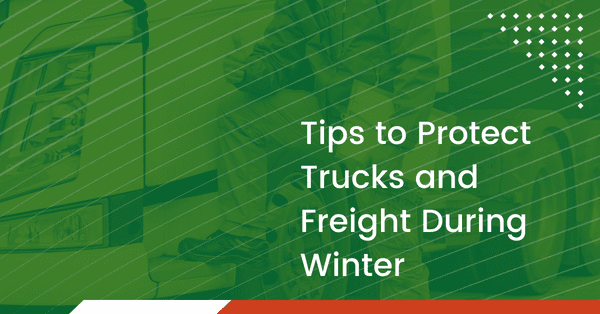Fridged winter weather can stress a company’s supply chain like no other. Both carriers and shippers feel the effects as everything from truck maintenance to ensuring that freight arrives in the proper condition is complicated by the cold, snow, and ice.
Learn more by subscribing to the PLS Logistics Services blog
Protecting and preparing trucks and freight for winter travel is imperative. Start by asking yourself a few questions:
- Is the truck prepped for the weather?
- Does my product need to be above a specific temperature regularly?
- Where is the product traveling?
- What are my transport options?
What Are You Shipping?
Fresh produce, meat, and other foods quickly come to mind as products that must maintain a specific temperature range. However, many medical products, such as vaccines, insulin, blood, and organs, are cold-sensitive and must be kept at a particular temperature or potentially diminish in quality.
They are not the only items that can lose their integrity in freezing temperatures, as liquids, certain chemicals, and solids such as cosmetics are sensitive products.
Knowing the limitations of what you are shipping gives you clarity on how to send the freight so that everything arrives in the requested condition.
Preparing Your Truck for Cold Weather
Carriers should carefully inspect their trucks before trips, especially during winter. A shipper’s freight is not going anywhere if the truck breaks down.
Check Door Latches and Other Moving Parts
Before and during trips, carriers should ensure all trailer and door latches are clean, unfrozen, and working properly.
Inspect The Tractor and Trailer Electrical Systems
Carefully inspect your batteries and ensure they are properly functioning and corrosion-free. Also, clean and tighten connections, check the wiring, and replace any damaged parts.
Inspect Coolant System
Conduct a pressure test on the coolant system along with the radiator cap. You will also want to inspect the water and heater hoses for general wear and tear, hardening, and cracks. Replace any that are damaged and tighten loose clamps.
Inspect Headlights and Other Lights
Before each trip, be sure that all lights and headlights are working properly. While on the route, keep lights clear of snow and road grime. This practice alone will decrease accidents in the event of a winter storm.
Ensure That Water Separator and Fuel Filter Work Properly
As the temperature drops, carriers should monitor their water separator and fuel filters. There is a tendency for condensation to form, so it is essential to drain the water regulator as needed. Carriers should have additional filters on hand before leaving, as there is no guarantee that gas stations along the route will have any to purchase.
Use Anti-Gel Fuel Additives
Using anti-gel additives ensures that fuel will continue to flow through the filter easily. It is best to add the additives before refueling the truck. As with filters, carriers should have the additives on hand before leaving, just in case there are none to purchase along the route.
Consider An Electric Block Heater
Using an electric block heater protects the engine from extreme temperatures when the truck is not running.
Have Winter Supplies with You
Always have blankets, warm clothing, food, water, a flashlight, a shovel, tire chains, and something to help with traction (kitty litter, sand, etc.).
How to Protect Your Freight from The Elements
Refrigerated Trailers (Reefers)
A Reefer truck’s design allows them to carry perishable freight at specific temperatures. While most think of them when carrying food during the summer months, they also protect the product from freezing during the winter.
While on the route, they constantly remain at a specific temperature, and customers can review logs to ensure that temperatures remain constant throughout the journey.
Heated Dry Vans
While a cheaper alternative to reefer trucks, heated dry vans are less reliable. Their temperature is not always consistent, especially during periods of extreme cold. Additionally, any product situated near the rear of the trailer may still be subjected to the effects of the outside temperatures if it is cold enough.
In these situations, it is vital that you closely monitor the weather over the route and that the carrier conducts temperature checks throughout.
Freeze Protection
Some carriers offer a service appropriately named ‘Protection from Freeze.’ This essentially is the carrier ensuring that the product is kept at a specific temperature so that there is no damage.
Shippers need to be sure that “protect from freeze” is listed on the bill of lading (BOL).
Additional Tips
Heated storage is beneficial if your product is going cross country. Throughout the country, there are heated warehouses where trucks can park overnight and still protect their load’s integrity.
Shippers should prepare their budgets for all the stated suggestions, which may result in a greater cost. Understand your options and clearly communicate with the carrier. This will safeguard your product and ensure it arrives in the best condition while avoiding damage and loss.
Utilize a 3PL
Using a 3PL, like PLS Logistics Services, can help take the logistical burden off your shoulders. Capacity on climate-controlled trucks can be limited, but our resources and carrier network of over 55,000 can help you get your freight to its destination on time. At PLS Logistics Services, we have experience in shipping full truckloads of items that must maintain their cold temperatures, such as organs, blood, vaccines, insulin, and more.


